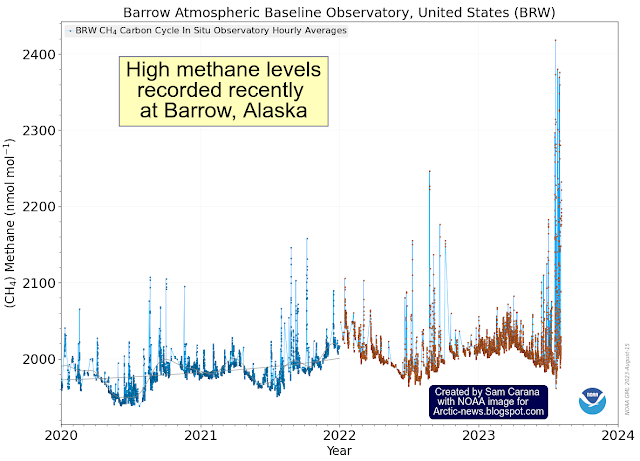More than 43,000 homes lose power as Storm Floris brings gusts of up to 82 mph, says a
BBC report of August 4, 2025.
 |
| [ click on images to enlarge ] |
As the temperature rise hits the Arctic harder than elsewhere in the world, the temperature difference between the North Pole and the Equator narrows, which slows down the jet stream and distorts its path, making the jet stream meander more.
As the jet stream slows down, distortion can cause parts of the jet stream at times to move faster. In the above image on the left, the polar jet stream and the subtropical jet stream have merged over the Atlantic Ocean, reaching speeds as high as 302 km/h or 187 mph over the North Sea on August 5, 2025 01:00 UTC (green circle on above image left).
 |
| [ click on images to enlarge ] |
Furthermore, as temperatures rise and oceans heat up, the increased energy can at times strongly speed up ocean currents and winds.
The above image shows sea surface temperatures as high as 32.7°C or 90.0°F, recorded south of Florida on August 3, 2025 12:00 UTC (at the green circle). The above image also shows the path of the Jet Stream (right) matching the path of the Gulf Stream (left), thus strengthening and speeding up the Gulf Stream and its extension North over the Atlantic Ocean and to the Arctic Ocean.
The image on the right shows North Atlantic sea surface temperatures as high as 32.8°C on August 5, 2025, and the image on the right underneath illustrates the huge amounts of heat that have accumulated in the ocean, showing equivalent ocean heat content on August 5, 2025.
Heat is moving up along the path of the Gulf Stream toward the Arctic, threatening to accelerate loss of sea ice and permafrost.
As temperatures rise, sea ice decline accelerates due to feedbacks such as the albedo feedback, i.e. less sunlight getting reflected by sea ice means more heat gets absorbed, further accelerating the temperature rise.
The image below shows Arctic sea ice concentration on August 7, 2025.
As illustrated by the image below, global sea ice extent was 21.89 million km² on August 5, 2025, a deviation of -4.71σ.
There are also tipping points, e.g. as sea ice volume declines over the years, the buffer disappears that previously consumed huge amounts of ocean heat in the process of melting the ice.
Arctic sea ice volume was at a record daily low on August 6, 2025, as it has been for more than a year, as illustrated by the image below.
 |
| [ NOAA ENSO outlook ] |
What makes the dire state of the sea ice even more significant is that there currently are no El Niño conditions. As illustrated by the image on the right, adapted from
NOAA, the ENSO outlook (CFSv2 ensemble mean, black dashed line) favors borderline La Niña during the Northern Hemisphere fall and early winter 2025-2026.
The temperature rise is accelerating and the rise could accelerate even more due to such feedbacks, especially during an El Niño and due to further reduction of the aerosol masking effect, two developments that could rapidly speed up existing feedbacks and trigger new feedbacks.
One of the most dangerous feedbacks is methane erupting from the seafloor of the Arctic Ocean. The image below shows hourly methane average recorded at the Barrow Atmospheric Baseline Observatory (BRW), a NOAA facility located near Utqiaġvik (formerly Barrow), Alaska, at 71.32 degrees North.
The image below shows that the degree to which sulfate aerosols scatter and absorb light was as high as 4.500 τ on August 5, 2025, at 04:00 UTC at the location marked by the green circle.
 |
| [ sulfates contribute to the aerosol masking effect ] |
The aerosol masking effect may be stronger than the IPCC's estimate, which would mean that the total warming due to people-caused emissions + feedbacks is higher. A 2022 study concludes that when ammonia, nitric acid and sulfuric acid are present together, they contribute strongly to the formation of cirrus clouds.
Once released in the upper troposphere, ammonia can form particles with nitric acid, which is abundantly produced by lightning. As described in an earlier post, more burning of biomass and more extreme weather events such as forest fires and lightning can come with huge releases of gases and aerosols. Another earlier post shows how forest fires can come with high releases of sulfur dioxide, raising suspicions that forest fires can revolatilize sulfur emitted over decades from coal-fired power plants and settled on forest soil. Sadly, the IPCC keeps downplaying the potential impact of feedbacks such as changes to ocean currents, wind patterns, clouds and water vapor, and loss of sea ice and permafrost, thus failing to warn people about a near-future in which temperatures could rise strongly due to such feedbacks, especially during an El Niño, and due to further reduction of the aerosol masking effect, developments that could rapidly speed up existing feedbacks and trigger new feedbacks, resulting in more extreme weather events striking with a ferocity, frequency and ubiquity that keeps increasing at an accelerating pace.
Climate Emergency Declaration
The situation is dire and the precautionary principle calls for rapid, comprehensive and effective action to reduce the damage and to improve the situation, as described in
this 2022 post, where needed in combination with a Climate Emergency Declaration, as discussed at
this group.
Links
• More than 43,000 homes lose power as Storm Floris brings gusts of up to 82 mph - BBC August 4, 2025
• NOAA - The Jet Stream
• University of Miami - Rosenstiel School - North Atlantic OHC
• University of Bremen
https://seaice.uni-bremen.de/start • NOAA - flask and station methane measurements
https://gml.noaa.gov/dv/iadv/index.php
• Synergistic HNO3 H2SO4 NH3 upper tropospheric particle formation - by Mingyi Wang et al.
https://www.nature.com/articles/s41586-022-04605-4discussed on facebook at:
https://www.facebook.com/groups/arcticnews/posts/10160005189729679
















































